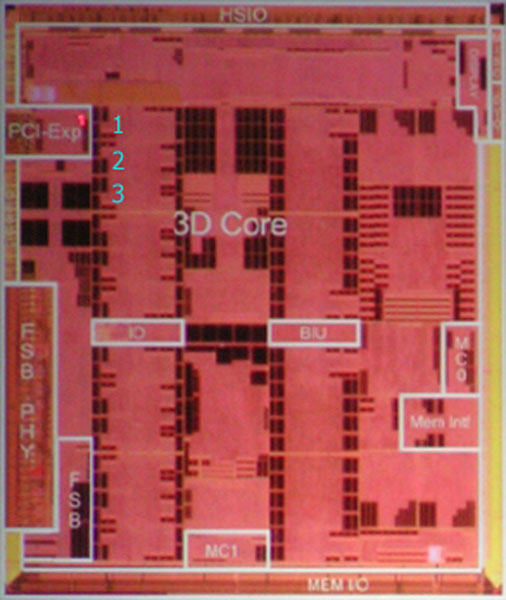I don't have any webspace to host images and I don't have permission to post attachements. What I'm proposing is that "US1" on your diagram takes care of parameter interpolation, and that the blocks of cache immediately to the right are the vertex cache.
If you zoom in on one of the US units you have marked you'll see two types of black rectangles: the darker, larger, "fatter" ones (just like the blocks in the area I think might be the vertex cache) and slightly thinner rectangles, which appear to be split in half. There are 9 of these per highlighted "US" block in your diagram (e.g. 18 total tiny blocks since each of these nine are split in 2). So my theory is that these 18 blocks are register files containing state for the currently active thread(s), and that some of the larger rectangular blocks are cache which hold state for stalled threads - thus leading me to speculate that each US unit actually has 18 pipes (2 redundant pipes for yield).
Anyway, this means that each US block could tolerate 2 "fatal" defects. Given the area of each of these US blocks, this seems much more reliable than requiring 3 out of 4 US blocks to contain no "fatal" defects whatsoever.
I'm not an EE though, so I wouldn't put too much stock into what I'm saying.
If you zoom in on one of the US units you have marked you'll see two types of black rectangles: the darker, larger, "fatter" ones (just like the blocks in the area I think might be the vertex cache) and slightly thinner rectangles, which appear to be split in half. There are 9 of these per highlighted "US" block in your diagram (e.g. 18 total tiny blocks since each of these nine are split in 2). So my theory is that these 18 blocks are register files containing state for the currently active thread(s), and that some of the larger rectangular blocks are cache which hold state for stalled threads - thus leading me to speculate that each US unit actually has 18 pipes (2 redundant pipes for yield).
Anyway, this means that each US block could tolerate 2 "fatal" defects. Given the area of each of these US blocks, this seems much more reliable than requiring 3 out of 4 US blocks to contain no "fatal" defects whatsoever.
I'm not an EE though, so I wouldn't put too much stock into what I'm saying.


